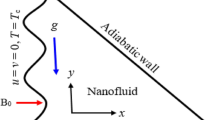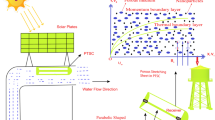Abstract
This analysis aims to determine the two-phase analysis of thermal transmission on MHD Eyring–Powell dusty hybrid nanofluid flow over a stretching cylinder with non-Fourier heat flux model and the influence of a uniform heat source and thermal radiation. The hybrid nanofluid was formulated by the mixture of Silicone oil-based Iron Oxide \((\text{Fe}_{3}\text{O}_{4})\) and Silver (Ag) nanoparticles flow properties after the mechanism has been filled with dusty particles. The increasing demand for sustainable sources of heat and electricity has inspired significant interest towards the conversion of solar radiation into thermal energy. Due to their enhanced ability to promote heat transmission, nanofluids can significantly contribute to enhancing the efficiency of solar-thermal systems. The non-linear equations for the velocity, energy, skin friction coefficient, and Nusselt number are solved using Bvp4c with MATLAB solver. Tables and graphs are used to show how essential parameters affect fluid transport properties. The temperature profile is decreased with greater Eyring–Powell fluid parameter values. The curvature parameter is intensified for the higher values of the velocity profile. The temperature is influenced by increasing values in the thermal radiation, while it is reduced by rising values in the thermal relaxation parameter. Increasing the value of the curvature parameter leads to a reduction in the skin friction factor. It is revealed that improving the values of the fluid–particle interaction for temperature and curvature parameter decrements for the Nusselt number.






















Similar content being viewed by others
References
Tao P, Shu L, Zhang J et al (2018) Silicone oil-based solar-thermal fluids dispersed with PDMS-modified Fe3O4@graphene hybrid nanoparticles. Prog Nat Sci Mater Int 28:554–562
Hussain M, Ali A, Ghaffar A, Inc M (2022) Squeezing flow of Casson fluid between two circular plates under the impact of solar radiation. J Therm Anal Calorim 147:6959–6969
Arshad M, Hussain A, Shah SAGA et al (2022) Thermal energy investigation of magneto-hydrodynamic nano-material liquid flow over a stretching sheet: comparison of single and composite particles. Alexandria Eng J 61:10453–10462
Bhattacharyya A, Sharma R, Hussain SM et al (2022) A numerical and statistical approach to capture the flow characteristics of Maxwell hybrid nanofluid containing copper and graphene nanoparticles. Chin J Phys 77:1278–1290
Hussain SM (2022) Thermal-enhanced hybrid of copper–zirconium dioxide/ethylene glycol nanofluid flowing in the solar collector of water-pump application. Waves in Random and Complex Media 1–28
Bouslimi J, Alkathiri AA, Althagafi TM et al (2022) Thermal properties, flow and comparison between Cu and Ag nanoparticles suspended in sodium alginate as Sutterby nanofluids in solar collector. Case Stud Therm Eng 39:102358
Jamshed W, Eid MR, Al-Hossainy AF et al (2022) Experimental and TDDFT materials simulation of thermal characteristics and entropy optimized of Williamson Cu-methanol and Al2O3-methanol nanofluid flowing through solar collector. Sci Rep 12:1–23
Reddy SRR (2022) Bio-magnetic pulsatile flow of Ti-alloy-Au/blood couple stress hybrid nanofluid in a rotating channel. Waves in Random and Complex Media, 1–24
Reddy SRR (2023) Entropy generation on biomagnetic gold-copper/blood hybrid nanofluid flow driven by electrokinetic force in a horizontal irregular channel with bioconvection phenomenon. Proc Inst Mech Eng Part C: J Mech Eng Sci 237:1631–1646
Shaik J, Polu BAR, Mohamed Ahmed M, Ahmed Mohamed R (2022) Characteristics of moving hot block and non-Fourier heat flux model on sinusoidal wavy cavity filled with hybrid nanofluid. Eur Phys J Plus 137:1–16
Jakeer S, Anki Reddy B (2021) Competence of magnetic dipole and radiation on permeable surface using prescribed heat flux/prescribed surface temperature and homogeneousheterogeneous reactions. Spec Top Rev Porous Media 12:91–107
Jakeer S, Reddy SRR, Rashad AM et al (2023) Nonlinear analysis of Darcy–Forchheimer flow in EMHD ternary hybrid nanofluid (Cu–CNT–Ti/water) with radiation effect. Forces Mech 10:100177
Jakeer S, Reddy PBA (2023) Stability analysis of electrical magneto hydrodynamic stagnation point flow of Ag-Cu/water hybrid nanofluid over a permeable stretching/shrinking slendering sheet: Entropy generation. Proc Inst Mech Eng Part E: J Proc Mech Eng 1–13
Jamshed W, Safdar R, Brahmia A et al (2023) Numerical simulations of environmental energy features in solar pump application by using hybrid nanofluid flow: Prandtl–Eyring case. Energy Env 34:780–807
Waqas M, Gulshan N, Asghar Z et al (2021) Visualization of stratification based Eyring–Powell material flow capturing nonlinear convection effects. J Therm Anal Calorim 143:2577–2584
Salawu SO, Obalalu AM, Fatunmbi EO, Oderinu RA (2022) Thermal Prandtl–Eyring hybridized MoS2-SiO2/C3H8O2 and SiO2–C3H8O2 nanofluids for effective solar energy absorber and entropy optimization: a solar water pump implementation. J Mol Liq 361:119608
El Din SM, Darvesh A, Ayub A et al (2022) Quadratic multiple regression model and spectral relaxation approach for Carreau nanofluid inclined magnetized dipole along stagnation point geometry. Sci Rep 12:1–18
Fortov VE, Vaulina OS, Petrov OF et al (2007) Experimental study of the heat transport processes in dusty plasma fluid. Phys Rev E Stat Nonlinear Soft Matter Phys 75:26403
Hassan A, Hussain A, Arshad M et al (2022) Insight into the significance of viscous dissipation and heat generation/absorption in magneto-hydrodynamic radiative Casson fluid flow with first-order chemical reaction. Front Phys 10:1–16
Ahmad S, Ali K, Rizwan M, Ashraf M (2021) Case studies in thermal engineering heat and mass transfer attributes of copper–aluminum oxide hybrid nanoparticles flow through a porous medium. Case Stud Therm Eng 25:100932
Ahmed SE, Arafa AAM (2023) 3D MHD dusty nanofluid flow within cubic heterogeneous porous enclosures with hot and cold cylinders using non-homogeneous nanofluid model. Proc Ins Mech Eng Part E: J Proc Mech 237:1202–1213
Umeshaiah M, Madhukesh J, Khan U et al (2022) Dusty nanoliquid flow through a stretching cylinder in a porous medium with the influence of the melting effect. Process 10:1065
Rehman SU, Fatima N, Ali B et al (2022) The Casson dusty nanofluid: significance of Darcy–Forchheimer law, magnetic field, and non-Fourier heat flux model subject to stretch surface. Mathematics 10:2877
Ullah I, Ali F, MohamadIsa S et al (2023) Electro-magnetic radiative flowing of Williamson-dusty nanofluid along elongating sheet: nanotechnology application. Arab J Chem 16:104698
Jakeer S, Reddy PBA (2022) Entropy generation on the variable magnetic field and magnetohydrodynamic stagnation point flow of Eyring–Powell hybrid dusty nanofluid: solar thermal application. Proc Inst Mech Eng Part C J Mech Eng Sci 236:1–14
Garvandha M, Nagaraju G, Kumar D, Chamkha AJ (2022) Study of different heating effects on two-phase flow of magnetized couple stresses over a permeable stretching cylinder with velocity slip and radiation. Int J Appl Comput Math 8:1–17
Roy NC, Hossain A, Pop I (2022) Flow and heat transfer of MHD dusty hybrid nanofluids over a shrinking sheet. Chin J Phys 77:1342–1356
Sajid T, Jamshed W, Safdar R et al (2022) Features and aspects of radioactive flow and slippage velocity on rotating two-phase Prandtl nanofluid with zero mass fluxing and convective constraints. Int Commun Heat Mass Transf 136:106180
Hussain SM (2022) Dynamics of radiative Williamson hybrid nanofluid with entropy generation: significance in solar aircraft. Sci Rep 12:1–23
Jamshed W, Uma Devi SS, Goodarzi M et al (2021) Evaluating the unsteady Casson nanofluid over a stretching sheet with solar thermal radiation: an optimal case study. Case Stud Therm Eng 26:101160
Jakeer S, Polu BAR (2022) Homotopy perturbation method solution of magneto-polymer nanofluid containing gyrotactic microorganisms over the permeable sheet with Cattaneo–Christov h>eat and mass flux model. Proc Inst Mech Eng Part E: J Proc Mech Eng 236:525–534
Chu YM, Jakeer S, Reddy SRR et al (2023) Double diffusion effect on the bio-convective magnetized flow of tangent hyperbolic liquid by a stretched nano-material with Arrhenius catalysts. Case Stud Therm Eng 44:102838
Arshad M, Hussain A, Hassan A et al (2022) Heat and mass transfer analysis above an unsteady infinite porous surface with chemical reaction. Case Stud Therm Eng 36:102140
Powell RE, Eyring H (1944) Mechanisms for the relaxation theory of viscosity. Nature 154:427–428
Aziz A, Jamshed W, Aziz T et al (2021) Features and aspects of radioactive flow and slippage velocity on rotating two-phase Prandtl nanofluid with zero mass fluxing and convective constraints. J Therm Anal Calorim 143:1331–1343
Javed T, Faisal M, Ahmad I, Faisal M (2020) Dynamisms of solar radiation and prescribed heat sources on bidirectional flow of magnetized Eyring–Powell nanofluid. Case Stud Therm Eng 21:100689
Islam N, Pasha AA, Jamshed W et al (2022) On Powell–Eyring hybridity nanofluidic flow based carboxy-methyl-cellulose (CMC) with solar thermal radiation: a quadratic regression estimation. Int Commun Heat Mass Transf 138:106413
Arshad M, Hassan A (2022) A numerical study on the hybrid nanofluid flow between a permeable rotating system. Eur Phys J Plus 137:1–13
Arshad M, Hassan A, Haider Q et al (2022) Rotating hybrid nanofluid flow with chemical reaction and thermal radiation between parallel plates. Nanomaterials 12:1–20
Hussain SM, Jamshed W (2021) A comparative entropy based analysis of tangent hyperbolic hybrid nanofluid flow: implementing finite difference method. Int Commun Heat Mass Transf 129:105671
Hussain SM (2022) Irreversibility analysis of time-dependent magnetically driven flow of Sutterby hybrid nanofluid: a thermal mathematical model. Waves Random Complex Media 1–33
Ramzan M, Shaheen N, Chung JD et al (2021) Impact of Newtonian heating and Fourier and Fick’s laws on a magnetohydrodynamic dusty Casson nanofluid flow with variable heat source/sink over a stretching cylinder. Sci Rep 11:1–19
Vajravelu K, Prasad KV, Santhi SR (2012) Axisymmetric magneto-hydrodynamic (MHD) flow and heat transfer at a non-isothermal stretching cylinder. Appl Math Comput 219:3993–4005
Author information
Authors and Affiliations
Contributions
Shaik Jakeer conceptualized the problem, SRR Reddy completely solved and plotted the graphs, and ML Rupa wrote the manuscript. At last, all the authors read and approved the final version of the manuscript. Sekhar, SRR Reddy, and Shaik Jakeer completed the revision.
Corresponding author
Ethics declarations
Competing interests
The authors declare no competing interests.
Additional information
Publisher's Note
Springer Nature remains neutral with regard to jurisdictional claims in published maps and institutional affiliations.
Rights and permissions
Springer Nature or its licensor (e.g. a society or other partner) holds exclusive rights to this article under a publishing agreement with the author(s) or other rightsholder(s); author self-archiving of the accepted manuscript version of this article is solely governed by the terms of such publishing agreement and applicable law.
About this article
Cite this article
Reddy, S.R.R., Jakeer, S., Rupa, M.L. et al. Two-phase analysis on radiative solar pump applications using MHD Eyring–Powell hybrid nanofluid flow with the non-Fourier heat flux model. J Eng Math 144, 7 (2024). https://doi.org/10.1007/s10665-023-10306-2
Received:
Accepted:
Published:
DOI: https://doi.org/10.1007/s10665-023-10306-2




